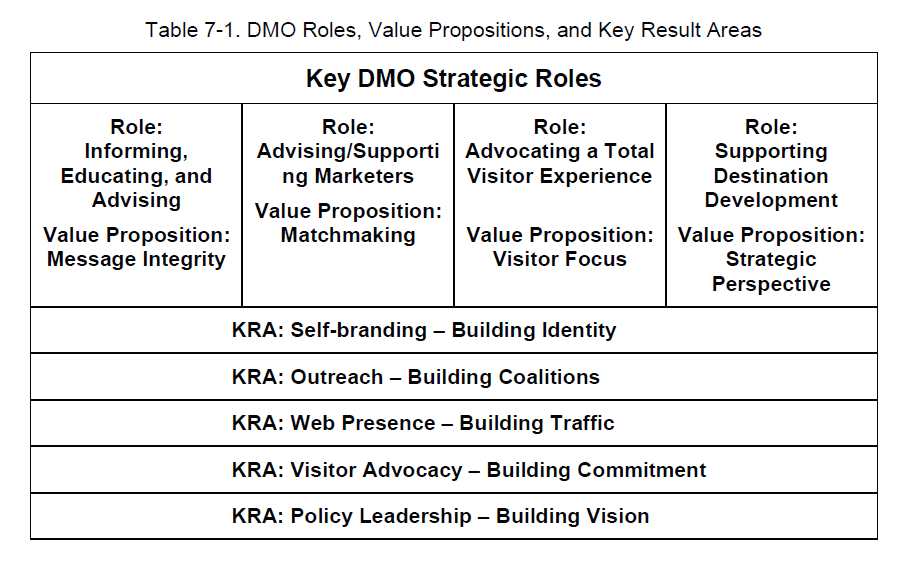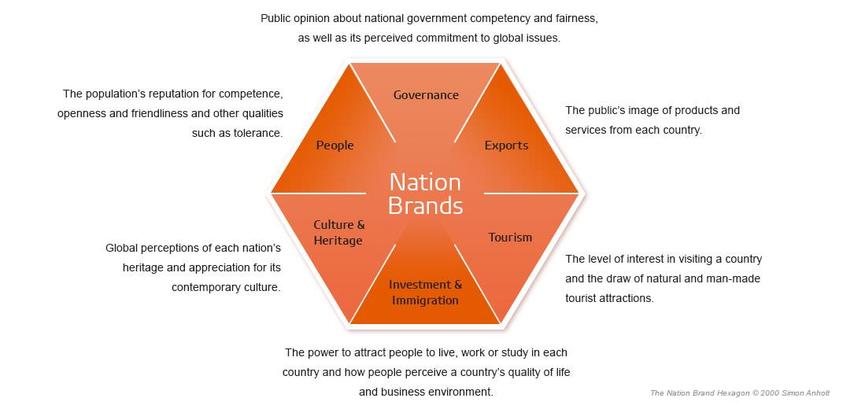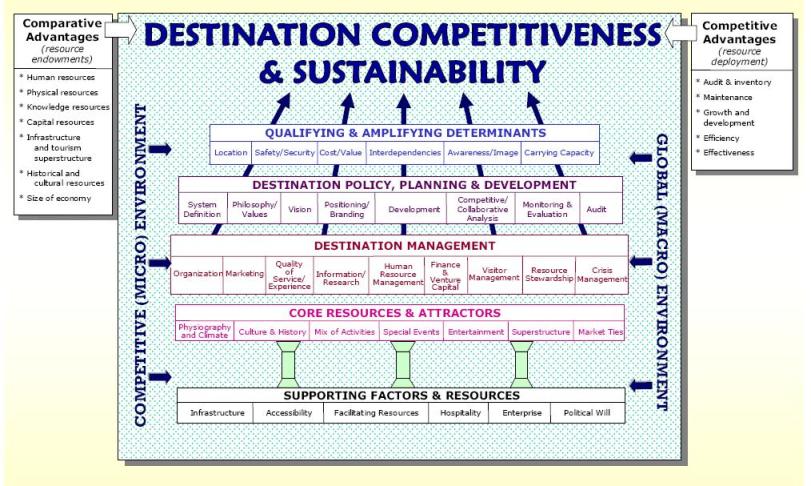

Destination Marketing is "a proactive, strategic, visitor-centered approach to the economic and cultural development of a location, which balances and integrates the interests of visitors, service providers, and the community." (Wikipedia, page @ archive.org, 2010)
This definition was proposed by business strategist and futurist, Dr. Karl Albrecht, and is endorsed by Destinations International, in its The Future of Destination Marketing Report (DMAI 2008), conducted for DMAI by Karl Albrecht International.
A destination has very much work to do to align with the perceptions and marketing framework that today's consumers have become accustomed to. All this may be to no avail if the fundamentals aren't right. (See Simon Anholt and Destination Competitiveness: Ritchie and Crouch, below)
In practical terms, everyday living is where the visitor experience unfolds. In this context, the destination's primary goal is to improve lives, both for visitors and residents. This is accomplished through educating workers and equally importantly, residents — at every level but especially the grassroots level — about the benefits of providing the best — positive, authentic, real experiences in every aspect of what they do. Happy people are more engaged and also more enabled to deliver positive results better and more easily because they have a sense of ownership of the outcome of their contribution. This must become nothing less than an embedded cultural value. In turn, this positivity is likely to be transferred to the visitor through interactions, both anticipated and accidental. This is the way to deliver experience. Local people benefit too as it is natural, as well as feeling good, to be hospitable. Visitors have a great time and tell anyone they meet about their experience. Destinations putting this understanding into action will excel and those who do not will continue to struggle. Its really that simple.
The benefit for all concerned is the removal, or at least the mitigation of internal resistance to moving forward on a tourism planning and development agenda*. Ultimately, every single person who becomes involved in tourism affects, or is affected by it. It follows that individuals with a positive and engaged presence will make a positive contribution. The flip side is that people who feel marginalized may harbour some negativity towards tourism, tourism development or by the politics and politicians who are being tasked to execute these plans. These individuals will not make a positive contribution and may possibly become adversaries of the development of tourism or even of tourists themselves. The outcome may be that this element is making development much harder and un-necessarily so. Also, one never knows if employment in a tourism related enterprise is a possible future outcome for any resident. Those who impress and contribute are far more likely to harvest this opportunity.
Take, for example, a worker in a retail store where the visitor has ventured to purchase some product. This purchase is not directly a component of the tourism product, however, the way that the visitor is treated by the worker will have a bearing in the perception of the people which the visitor takes away from the place. Another experience, where a visitor randomly stops someone to ask for directions. Once again, this visitor's impression of the people will be affected by how this individual responds to the request. These are examples outside the definition of the tourist experience but they are nonetheless formative in the total experience that the visitor captures.
Most destination marketing expenditure is targeted at potential visitors who have never visited. Seen from the perspective of cost to attract, most, if not all, of the marketing expenditure is meant to appeal to the first time visitor, just as most advertising works. And, while a destination may well attract the first time visitor, it is the repeat visitor where the real and sustainable long-term benefits of tourism lie. The second or subsequent visit has virtually no cost to attract associated with these visits, so they are add-on revenues with little to no add-on cost.
The point is: If there is no second visit, there is no add-on revenue from a visitor. A single visit bears all of the cost which makes this form of promotion very costly on a per visit basis. The person visits once and may never return. There is no long-term or lasting benefit derived from this visitor. With expectations un-fulfilled from a single visit, these visitors are always, in the competitive environment, looking at other places to travel to.
The tide turns dramatically when a visitor has had a fulfilling experience. The repeat visit is almost pure profit for destinations. Think about this in terms of increasing visitors without additional marketing costs. Repeat visitors are also more likely to tell friends about the place and how great it is, and encourage them to come along. Furthermore, repeat visitors now have more at stake with respect to the destination. It becomes their interest to work towards a quality experience for themselves, as well as anyone who may accompany them.
It is almost a futile exercise to attempt to use marketing techniques, such as loyalty campaigns or other enticements, to attract return visitors if the experience on the ground, face-to-face does not fulfill the visitors expectations. There is just too much competition for this to be practical.
So, whatever a destination is doing to develop, promote and market its tourism product, without any attempt to upgrade the elements of person-to-person contact, which can also be of random or accidental nature, is literally undermining its own efforts. The outcome is expending a great deal of money in marketing without knowing anything about the on-ground experiences of visitors and residents or acknowledging that these experiences also form a significant component of the overall visitor experience.
It is therefore highly likely to be beneficial to get more people aware and involved in the enhancement of visitor experiences, even when they are not directly involved in the delivery of services to these people. In sum, a way for the entire population of a destination to support and enhance the visitor experience is a progressive step. This simple understanding could go a long way to making the investment in developing and marketing a tourism product more worthwhile.
The objective of attracting tourists, who would otherwise be spending their money elsewhere, is to generate economic activity. In turn, this generates investment in facilities, employment for local residents and ultimately wealth for the destination as well as for businesses. It seems important that primary benefactors of wealth and income generation would be the residents themselves — employees or entrepreneurs. If not, than one has to wonder what the real purpose is.
A Destination Marketing Organization, or "DMO", is a stand-alone business entity - governmental, corporate, or nonprofit - that is responsible for leading and coordinating all of the marketing efforts on behalf of a particular destination. It is important to keep messaging consistent across all media and promotional outlets and the DMO is key in facilitating this.

Key roles of a Destination Marketing Organization (DMO) (source: DMAI)
The Caribbean Tourism Organization or CTO, is the lead DMO for the Caribbean, promoting travel to 31 Caribbean destinations: They have a Business site and a Consumer site.
On the other hand, a Destination Management Company or "DMC" is a term for a professional services company possessing extensive local knowledge, expertise and resources, specializing in the design and implementation of events, activities, tours, transportation and program logistics.
A DMC provides a ground service based on local knowledge of their given destinations. These services can be transportation, hotel accommodation, restaurants, activities, excursions, conference venues, themed events, gala dinners and logistics, meetings, incentive schemes as well as helping with overcoming language barriers.
Competitive identity: The new brand management for nations, cities and regions by Simon Anholt (Google Books)
• Chapter 1: What is Competitive Identity? (PDF)
"If ... the growing community of thinkers and practitioners in the field does
manage to raise the discussion to the level of intellect, responsibility, expertise and maturity that
it needs and deserves, it could be a very different story. Just as brand management has proved
to be one of the most potent instruments for devising strategy and creating wealth in the
commercial sector, so its application to the development and competitiveness of states, regions
and cities could have enormous and far-reaching impacts in the years to come."

The nation brand hexagon Source: nation-brands.gfk.com (@ archive.org, 2018)
Destination Competitiveness: Ritchie and Crouch
"The fundamental product in tourism is the destination experience. Competition, therefore, centres on the destination and ... its ability to increase tourism expenditure, to increasingly attract visitors while providing them with satisfying memorable experiences and to do so in a profitable way, while enhancing the well-being of destination residents and preserving the natural capital of the destination for future generations". (Ritchie and Crouch, 2000)
The Destination Competitiveness and Sustainability model found in Modelling Destination Competitiveness (PDF) can be used to assess the external macro and micro environment and the internal competitive attributes of a destination. This assessment forms a key part of developing appropriate strategies for destination development, management and marketing.

* A clear distinction must be made between residents who are impeding tourism development for no apparent reason and those who advocate for responsible use of resources. Time and time again, new resorts or infrastructure are built that clearly have negative impacts. In some cases, these impacts are beyond the destination's capacity to adapt. Further, promises of mostly low wage/low skill jobs almost never materialize. Citizen advocates who campaign against this sort of 'short term gain for long term pain' need to be recognized for their contribution to preserving resources for the future.